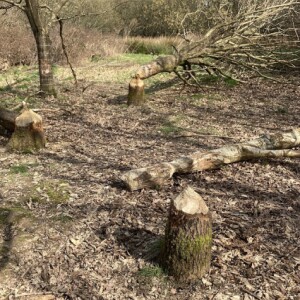We could see where they’d been
But we knew we wouldn’t see them. We went on a rare visit to the beaver pen at the Knepp rewilding project in Sussex. A pair of beavers have been living in the pen for 14 months. There used to be a small narrow stream running through the area, which dried up in the summer. Now they have created a big lake, several dams, a lodge (their home) and have felled or half felled many trees.
The first extra shows their tree felling methods. The second shows the top dam, and the lake it’s created. The third shows their lodge - fairly well disguised - it’s tent shaped, halfway up and two thirds to the right. The entrance is under water, the chambers inside are sealed with mud. Knepp staff are hoping for kits this year, as they have observed (via motion sensor night cameras) pairing up behaviour.
The fourth shows the extent of the top lake they’ve created. And the fifth shows the lower dam, and the difference in water levels created by the dam.
The point is that the introduction of beavers does so much for the environment. It saves water up for dry times, it slows down water flows at times of heavy rain so floods are much less likely in areas below their territory. By holding up the water a lot of the excess fertiliser in the water gets used up by margin plants, and the silt in the lakes absorbs pollution, and acts as a sink for carbon. Absolutely amazing. But their reintroduction needs to be managed properly so that farm land is not damaged and farmers do not lose their crops. There is space for both, according to the Knepp beaver team




Comments
Sign in or get an account to comment.


